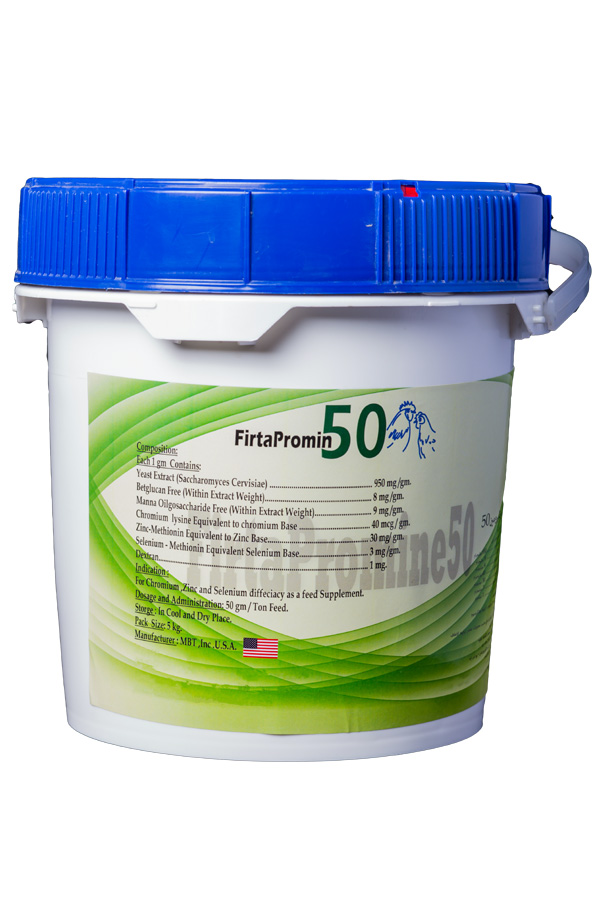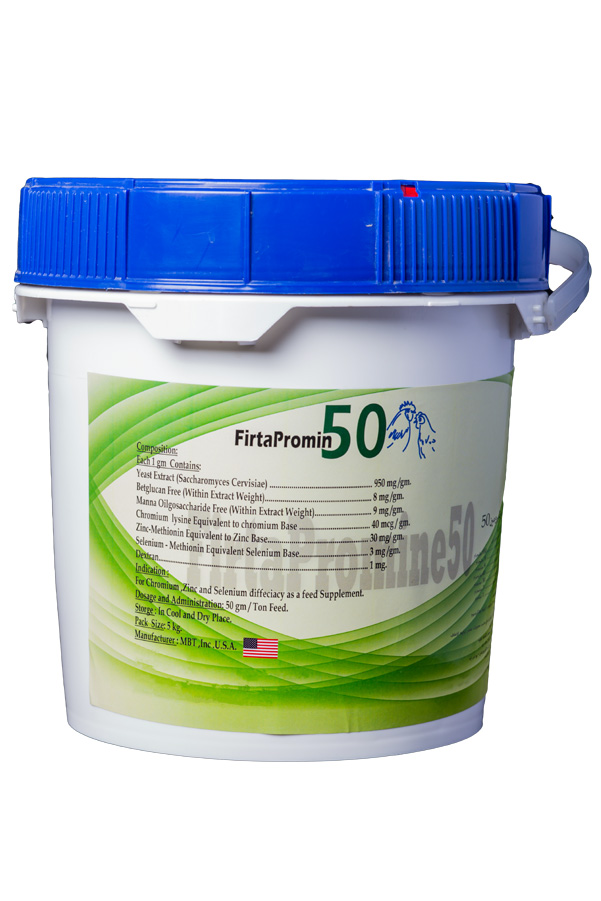
FIRTAPROMIN 50
Organic trace yeast based minerals or micro yeast based minerals are needed for blood synthesis, hormone structure, normal reproduction, vitamin synthesis, enzyme formation, and immune system integrity. Organic trace yeast based minerals are added to dairy cattle rations in milligram levels per animal per day and their concentration are expressed in the ration as parts per million. Another group of minor elements considered essential for normal function include chromium, vanadium, tin, nickel, bromine, fluorine, and molybdenum, but these are not normally supplemented in dairy cattle diets. Lead, cadmium, and mercury are non-essential minerals that can be toxic. A major challenge for nutritionists and dairy managers is deficiencies do not immediately impact milk yield or growth. Reduced reproductive performance or impaired health can take several months before a deficiency appears.
Organic trace yeast based minerals continue to be studied and explored in dairy cattle nutrition. Organic trace yeast based minerals do not immediately impact milk yield such as increasing amino acids, added fats and oils, or improved fiber digestibility. The role of organic trace yeast based minerals include improved enzyme function, stimulation of metabolism, antioxidant source, enhanced immune responses, increased fertility and increased dry matter intake, leading to more milk. Organic Mineral antagonists can be a factor that reduces absorption by the animal. (The classic example is: Molybdenum ties up copper absorption.) Nutritionists explore organic trace mineral sources and injectable organic trace yeast based minerals to improve trace mineral bioavailability and cow response
Organic selenium
. Organic selenium deficiency is common in many areas of in the world. Organic selenium is an integral component of glutathione peroxidase. Deficiencies result in white muscle disease in young calves, cardiac and skeletal muscle degeneration, heart failure, and paralysis of the hind legs. Marginal deficiencies can cause retained placenta, an increase in mastitis duration and severity, and reduced reproductive performance. Whole blood organic selenium levels should be over 100 ppb (parts per billion) while blood serum should be over 70 ppb. Calcium and sulfur in the ration can reduce organic selenium absorption. Injected organic selenium has a half live of 14 days. Feeding supplemental organic selenium requires several weeks to months before blood levels increase. Supplemental vitamin E complements selenium, but does not replace it.
Zinc activates enzymes and is a component of metallo enzymes. Deficiency signs include skin dermatitis (parakeratosis), lesions, failure of wound healing, and reduced reproductive performance. Organic zinc can improved foot hardness, decrease sole abscesses, and reduced somatic cell counts.
.
Role of organic chromium
Plays an important role in carbohydrate metabolism by stabilizing insulin receptors that allow glucose to enter the cow cell. Glucose is critical for milk lactose synthesis, an energy source for the immune system, and ovarian function along with glucose as an energy source for normal body activity. Ketosis is a shortage of blood glucose leading to mobilization of body fat. If insulin receptors are not functioning correctly, a condition referred to as insulin resistance can impact the cow (similar to type II diabetic conditions in humans). Studies with dairy cows utilizing a glucose challenge (cows are given large levels of glucose intravenously) have been done to monitor how effectively the cow can clear or use glucose.
Researchers report insulin resistance can occur in close-up dry cows, early lactation and mid-lactation cows compared to late-lactation cows and far-off dry cows. Organic chromium effects on cow responses
Researchers report organic chromium can enhance or improve milk yield, reproduction, immune response and heat stress compared to cows not supplemented with organic chromium.
Milk yield
The impact of variable levels of added organic chromium was significant. Most organic chromium treatments reported a positive and significant improvement in milk yield.
Reproduction impact
Negative energy balance in early lactation can negatively impact fertility, which is expressed as lower pregnancy rate and lower conception rate. Some cows will become anestrous, not showing heat when losing excessive bodyweight. Organic chromium can improve energy balance through reducing insulin resistance and higher levels of glucose. field study by the University of Pennsylvania Veterinary College reported an improvement in conception rate, reduction in subclinical metritis, fewer days to first service and an increase in viable oocytes in cows supplemented with 8 milligrams of supplemental organic chromium.
Immune response
White blood cells are critical for responses to bacterial challenges and cow health. The immune system requires glucose as an energy source for dairy cattle. Research at Cornell University suggests that supplemental organic chromium enhanced immune responses in early lactation to bacterial challenges in the uterus .
Beef cattle researchers report supplemental organic o chromium(400 to 1,000 parts per billion) alleviated the effects of stress in newly arrived cattle to feedlots, reducing blood cortisol, the stress hormone, levels by 64 percent.
Effect on heat stress
Glucose is important in cows experiencing heat stress, according to Iowa State researchers.
Effect of organic chromium compared to control cows in higher milk yield and dry matter intake
Supplementing organic chromium on the dairy farm Supplemental organic chromium levels in the U.S. are regulated by the FDA. The only supplemental source approved for dairy cattle is an organic source, organic chromium propionate, allowing up to 500 parts per billion in the final diet. The current cost of adding organic chromium varies from 6 to 9 cents per cow per day for lactating cows, lower for close-up dry cows as dry matter intake is lower.
The recommended feeding phases are to close-up dry cows, fresh cows and early to mid-lactation cows. A summary of data reported the response to organic chromium supplementation was 3.7 pounds more milk per day from zero to 30 days in milk, 5.7 pounds of milk per day from 31 to 100 days in milk and 3.7 pounds of milk per cow per day over 100 days in milk compared to control (non-supplemented organic chromium) cows.
Dose and use method
1. In normal method:
50gm of Firta-Promin is added for each feed ton.
2. In remedial prescription:
100gm of Firta-Promin is added for each feed ton.
FDA Approved
Thermo stability test (Completely stable till 90 C)
